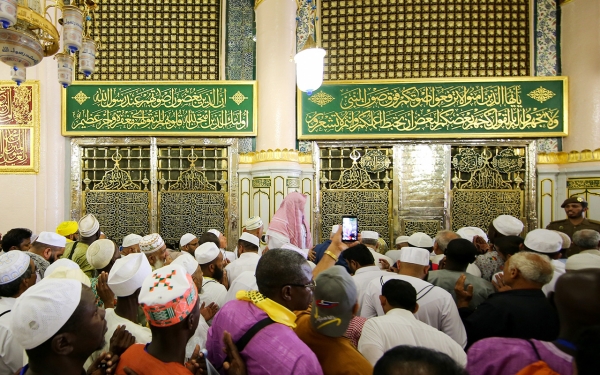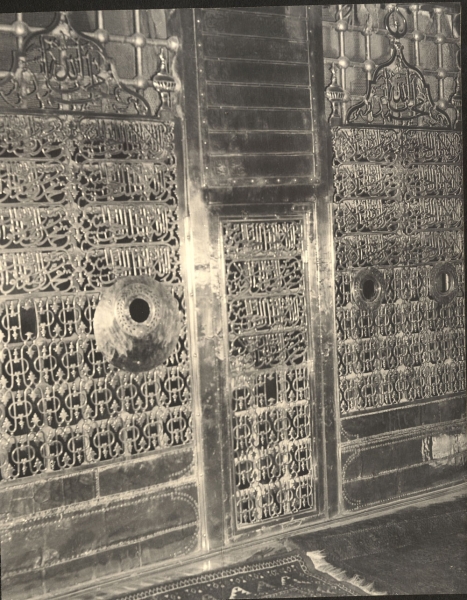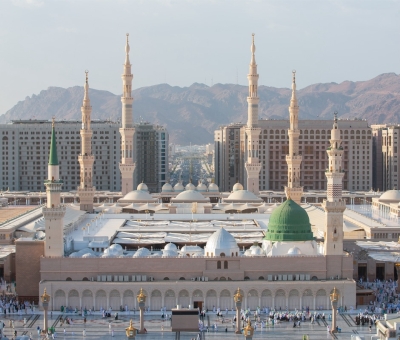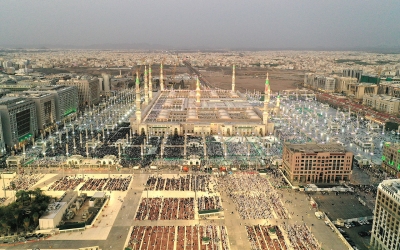


The Tomb of Prophet Muhammed contains Prophet Muhammed's peace be upon him (PBUH) gravesite and is located in Prophet's Mosque in al-Madinah al-Munawwarah. It is also called the Sacred Chamber. It served as the abode for Prophet Muhammed and his wife Aisha Bint Abu Bakr al-Siddiq, the Mother of Believers (may Allah be pleased with them). He built this chamber after his arrival in al-Madinah and the construction of his noble mosque. Following the passing of the Prophet, the tomb included the graves of his Companions, Umar Bin al-Khattab and Abu Bakr, to his side, may Allah be pleased with them, each buried an arm's length apart. Each visitor to the Prophet's Mosque stands to pay their respects to the Prophet Muhammed (PBUH) and his companions at its front facade.
Contents of the Tomb of Prophet Muhammed
The Tomb of Prophet Muhammed consists of a roofed room, measuring approximately two m in height and covering an area of 17.75 m. Attached is an unroofed room with a 1.6 m-high wall. The northern and western walls are about 2.5 m long, and the northern and southern walls are about 5.24 m long. The door to the Tomb of Prophet Muhammed opened to al-Rawda al-Sharifa, east of the mosque. The Prophet (PBUH) would turn his head in Aisha's direction while in seclusion there, and she would proceed to comb his hair.
The Prophet (PBUH) was interred in the Noble Prophet's Chamber. Following his passing, his Companions deliberated on the appropriate location for his burial. It is probable that Abu Bakr al-Siddiq recalled the Prophet's teaching that every prophet should be laid to rest in the place of their demise. Consequently, his grave was situated in the southern section of the chamber.
Aisha, the Mother of Believers, remained in the chamber after the Prophet (PBUH) was buried there. She did not erect a barrier between her and his grave, even after the passing of Abu Bakr Al-Siddiq. She stated that these were her husband and father. After Umar Bin al-Khattab's death, she set up a partition between herself and the graves.
The Tomb of Prophet Muhammed's doors
The Tomb of Prophet Muhammed has six doors from all sides. The first is the door on the south side of the chamber, known as bab al-Tawbah or the Door of Repentance. It is adorned with a silver plate that indicates its year of construction in 1617. The northern door is named bab al-Tahajjud or Night Prayer Door. The eastern door is named bab Fatima or the Door of Fatima. The western door is named bab al-Nabi or Prophet's Door, also known as bab al-Wufud or the Door of Delegations Finally, there is a door on each of the right and left sides of the triangular structure inside the compartment.
Repairs to the Tomb of Prophet Muhammed
There have been numerous repairs and renovations to the Tomb of Prophet Muhammed. The first was by Umar Bin al-Khattab when visiting the Prophet's Mosque in 639, as he replaced palm branches used in the chamber with stone. In 707 and 711, Caliph Umar Bin Abdulaziz rebuilt the Sacred Chamber with black stones in the same space the Prophet Muhammed's (PBUH) house was built. He then added a wall with five sides, designing it so it featured a triangle in the back, in an attempt to make its design different from al-Kaba al-Musharrafa.
Looting the Tomb of Prophet Muhammed
The Tomb of Prophet Muhammed was looted by Fakhri Pasha, the Ottoman military governor of al-Madinah al-Munawwarah in 1917 during the Ottoman Empire's occupation. The contents taken were transported via the Hejaz Railway to Istanbul, where they illegally remain, displayed in museums, despite being possessions of Islamic heritage that belong to the Prophet's Mosque.
The Tomb of Prophet Muhammed in the Saudi era
During the Saudi era, the Tomb of Prophet Muhammed has retained its old structure. It is maintained, reinforced, and cleaned as necessary, supervised by the General Presidency for the Affairs of the Grand Mosque and the Prophet's Mosque.
Related quizzes

